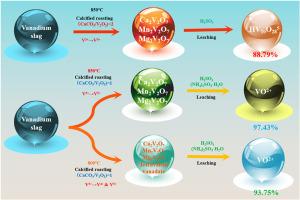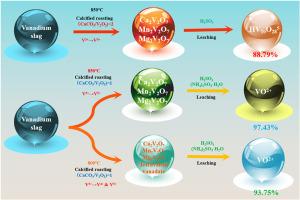钒渣中更清洁高效的提钒:钙化焙烧与还原浸出工艺的最佳适应机制
IF 10
1区 环境科学与生态学
Q1 ENGINEERING, ENVIRONMENTAL
引用次数: 0
摘要
如何从钒渣中高效回收关键金属钒,同时减少石灰石用量,降低焙烧温度是一个关键的挑战。本文报道了钒渣钙化焙烧条件对钒在新型H2SO4 - (NH4)2SO3·H2O还原浸出体系中浸出行为的影响。此外,我们首次阐明了焙烧过程中形成的各种相纯钒酸盐化合物的溶解行为,从而揭示了钙化焙烧与还原浸出过程之间的适应机制。结果表明,该还原浸出体系的最佳焙烧工艺适应性为n(CaCO3/V2O3) = 1,焙烧温度为850℃,焙烧时间为120 min,升温速率为5℃/min,钒浸出率可达97.43%。与传统的钙化焙烧- H2SO4浸出工艺相比,钒浸出效率提高了8.64%,CaCO3用量降低了50%。即使焙烧温度降低50℃,钒浸出率仍保持在93.75%。通过充分利用钒渣中固有的Mn和Mg进行钒酸盐转化,使Mn和Mg对提钒的贡献分别提高了9.24%和2.28%,从而大大降低了对石灰石的依赖,同时还原浸出体系与钒酸盐相变相适应。H2SO4和(NH4)2SO3·H2O的协同作用促进了钒酸盐的分解,抑制了钒的水解,实现了Ca2V2O7、Mn2V2O7和Mg2V2O7的100%溶解。低钙焙烧-还原浸出新工艺降低了焙烧添加剂成本和CO2排放量50%,降低了尾矿石膏产量50%,为钒渣的清洁利用提供了一条新途径。本文章由计算机程序翻译,如有差异,请以英文原文为准。


Cleaner and efficient vanadium extraction from vanadium slag: optimal adaptation mechanism between calcification roasting and reductive leaching processes
Efficient recovery of critical metal vanadium from vanadium slag, while reducing the use of limestone and lowering the roasting temperature is a pivotal challenge. Here, we report the effect of calcification roasting conditions of vanadium slag on the leaching behaviour of vanadium in a novel H2SO4 - (NH4)2SO3·H2O reductive leaching system. Furthermore, we elucidate for the first time the dissolution behaviour of various phase-pure vanadate compounds formed during roasting, thereby uncovering the adaptation mechanism between calcification roasting and reductive leaching process. The results show that the optimum roasting process adaptation for the reductive leaching system was n(CaCO3/V2O3) = 1, with a roasting temperature of 850 °C for 120 min and a heating rate of 5 °C/min, the vanadium leaching efficiency reached 97.43 %. Compared to the conventional calcification roasting - H2SO4 leaching process, vanadium leaching efficiency increased by 8.64 %, whilst CaCO3 consumption was reduced by 50 %. Even with a 50 °C reduction in roasting temperature, vanadium leaching efficiency remained at 93.75 %. By fully utilizing the inherent Mn and Mg in vanadium slag for vanadate conversion, increased the contribution of Mn and Mg to vanadium extraction by 9.24 % and 2.28 %, respectively, thereby reliance on limestone is greatly reduced, meanwhile the reduction leaching system is perfectly adapted to the vanadate phase transformation. Synergistic action of H2SO4 and (NH4)2SO3·H2O promotes vanadate decomposition and inhibits vanadium hydrolysis, achieving the 100 % dissolution of Ca2V2O7, Mn2V2O7, and Mg2V2O7. This new low calcium roasting - reduction leaching process reduces roasting additive costs and CO2 emissions by 50 %, and decreases the tailings gypsum production by 50 %, this offer a new path for cleaner utilization of vanadium slag.
求助全文
通过发布文献求助,成功后即可免费获取论文全文。
去求助
来源期刊

Journal of Cleaner Production
环境科学-工程:环境
CiteScore
20.40
自引率
9.00%
发文量
4720
审稿时长
111 days
期刊介绍:
The Journal of Cleaner Production is an international, transdisciplinary journal that addresses and discusses theoretical and practical Cleaner Production, Environmental, and Sustainability issues. It aims to help societies become more sustainable by focusing on the concept of 'Cleaner Production', which aims at preventing waste production and increasing efficiencies in energy, water, resources, and human capital use. The journal serves as a platform for corporations, governments, education institutions, regions, and societies to engage in discussions and research related to Cleaner Production, environmental, and sustainability practices.
 求助内容:
求助内容: 应助结果提醒方式:
应助结果提醒方式:


